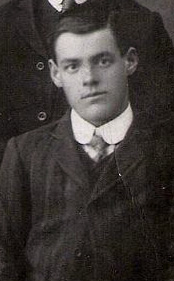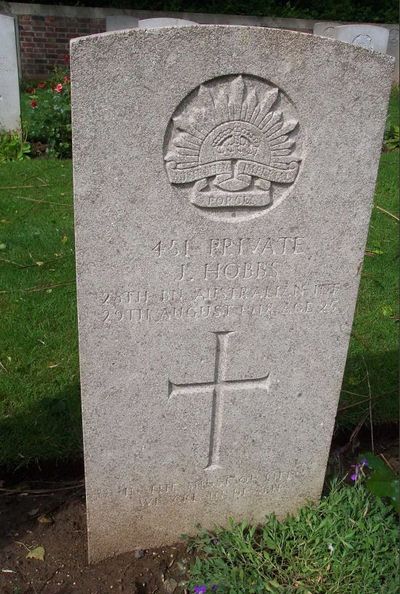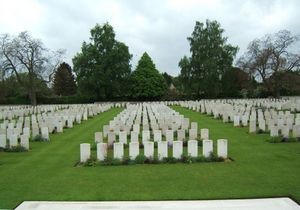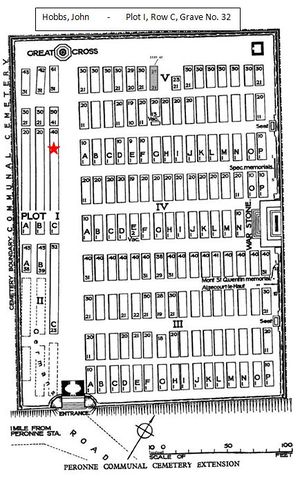John Hobbs
From Our Contribution
 courtesy arrowsmith33 @ ancestry.com.au | |
 | |
| Personal Information | |
|---|---|
| Date of Birth | 28 Oct 1893 |
| Place of Birth | Bidderford, Devonshire, England |
| Death | 29 Aug 1918 |
| Place of Death | Albert, France |
| Age at Enlistment | 22 years, 5 months |
| Description | 5'5¾" (1.67m) tall; weight 136 lbs (61.7 kg); dark complexion, brown eyes, dark hair |
| Occupation | farm labourer |
| Religion | Presbyterian |
| Address | 'Mill Lane Farm', Beenup, Western Australia |
| Next of Kin | Father Mr Thomas Heard Hobbs |
| Military Information | |
| Reg Number | 451 |
| Date of Enlistment | 8 Mar 1915 |
| Rank | Private |
| Unit/Formation | 28th Battalion, C Company / 7th Brigade, 2nd Division |
| Date of Embarkation | 9 Jun 1915 - 30 Jun 1915 |
| Ship Embarked On | HMAT A11 Ascanius |
| Fate |
Wounded in Action 3 May 1917 2nd Bullecourt Wounded in Action 4 Oct 1917 Broodseinde Wounded in Action 24 Apr 1918 Villers-Bretonneux Killed in Action 29 Aug 1918 Flaucourt, France |
| Monument |
Armadale War Memorial (Beenup panel) Armadale and Districts Roll of Honour Australian War Memorial |
| Medals |
1914-15 Star British War Medal Victory Medal |
Contents
Pre War
1915 Electoral Roll entry - farm hand at "Mill Lane Farm" Beenup.
War Service
Entered camp on 8 Mar 1915 as a member of 11 Depot Company before being allocated to C Company of the 28th Battalion. After several months basic training they embarked for Egypt where they undertook further training before 4 Sep 1915 when the 28th Battalion embarked on HMT Ivernia in Alexandria for Gallipoli.
John served on the Gallipoli Peninsular from early September 1915 until the evacuation in December. (The 28th Battalion less some of its machine gunners were evacuated to Mudros aboard HMS Osmanieh at 6:00am 13 Dec 1915. John arrived back in Alexandria from Mudros aboard HMT Ausonia on 9 Jan 1916 (disembarked on the 10th) which had left Mudros harbour early on the 6th. Following a rebuild and some training, they were then sent on to Marseilles in France via Alexandria 16 - 21 March 1916.
At the second Bullecourt battle on 3 May 1917 John would have been engaged in fighting along the OG1 and OG2 trenches using grenades (bombs) as his unit and others before them had repeatedly bombed their way along trenches capturing them, only to be pushed back by strong counterattacks. This happened 5 or 6 times, with the 28th Battalion engaged in the 4th and subsequent phases. During one of these phases John received a GSW to his left arm. Treated first by the 5th Australian Field Ambulance before being seen by the 3rd Australian Casualty Clearing Station on 3 & 4 May before being evacuated to the 5th General Hospital in Rouen from 4 - 17 May 1917. He was evacuated to England from Rouen on 17 May 1917 aboard the HMT Aberdonian, and admitted on 18 May 1917 to 1st Southern General Hospital at Stirchley (near Birmingham) for treatment until 5 Jun 1917 for what was then described as a severe wound to his left shoulder.
He remained in England for the best part of 4 months. While waiting to go back to France at Perham Downs he was AWOL for 16 days and awarded 28 days detention and forfeited 48 days pay. He rejoined the 28th Battalion rear detail on 20 Sep 1917 (via the HMT Aberdonian on 11 Sep 1917) while the battalion was involved in the Battle for Menin Road, and the battalion proper on 29 Oct 1917.
John was wounded in action for the second time on 4 Oct 1917 at Broodseinde with a GSW to his thigh, when he was one of the day's heavy casualties (6 Officers wounded, 42 ORs KIA, 85 WIA, and 5 Missing). [Neville Bowning's The Blue & White Diamond put the losses at one officer and 45 other ranks killed and eight officers and 102 other ranks wounded since 1 Oct 1917.][1] Admitted tot he 17th Casualty Clearing Station on 7 Oct 1917, he entered the 14th General Hospital at Boulogne the next day for two days before being released to the 1st Convalescent Depot on 10 Oct 1917. John rejoined the battalion on 29 Oct 1917.
The battalion's War Diary described 24 Apr 1918 as a "dry but dull day", although in the reserve lines near Villers-Bretonneux, John was WIA for the 3rd time by a retaliatory German artillery barrage. He suffered a severe shell wound to his right knee and abdomen wall. Treated by the 6th Australian Field Ambulance that day and by the 4th Casualty Clearing Station the next day, he entered the 9th General Hospital in Rouen on 25 Apr 1917. On 27 Apr 1917 he was again evacuated to England, this time on HMHS St Patrick, and was admitted to 1st Southern General Hospital at Birmingham on 28 Apr 1918. Discharged from hospital, he spent 6 - 20 Jun 1918 in a convalescent depot.
Arriving back in France on 3 Aug 1918 via Folkestone, he rejoined the 28th Battalion on 11 Aug 1918, and then on the 29th August 1918 his luck finally ran out when he was Killed in Action near Biaches Wood at Flaucourt during the advance up the Somme River. The Battalion War diary entry for the day includes "The casualties were exceedingly light on our side."
Notes
Mentioned in the 1917 Feb-Mar edition of The Drill of the Foot-Hills, but no detail given.
- ↑ Neville Browning. The Blue & White Diamond, page 320. Advance Press

